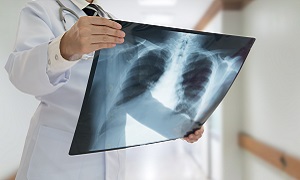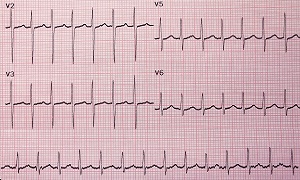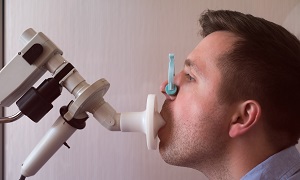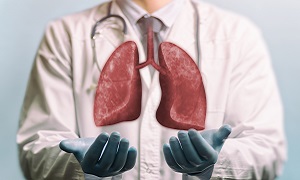Pulmonary Fibrosis
Pulmonary fibrosis is a lung disease known to occur when lung tissue gets damaged and scarred. This thickened, stiff tissue makes the working of your lungs quite difficult, and as the condition worsens, the patient even becomes shorter of breath.
The scarring associated with pulmonary fibrosis may be caused by several causes, though in most cases, doctors are unable to pinpoint the exact cause of the problem. The condition is termed idiopathic pulmonary fibrosis.
Though the lung damage that is caused by this condition can’t be repaired, medications and therapies may help in easing the symptoms and improve the quality of life. A lung transplant can also be considered for some patients.
Symptoms
There are multiple signs of pulmonary fibrosis, which can include the following:
- Shortness of breath
- Fatigue
- A dry cough
- Aching muscles and joints
- Unexplained weight loss
- Widening and rounding of the tips of the fingers or toes
The severity of symptoms generally varies from person to person. Some people can become ill very quickly, while others have moderate symptoms, which worsen more slowly, over months or years.
Some people might experience a rapid worsening of their symptoms, which can last for several days to weeks. This is termed as acute exacerbations, and people experiencing this might be placed on a mechanical ventilator. Doctors may also prescribe antibiotics or other medications in such cases.
Causes & risk factors
Pulmonary Fibrosis can be caused by several conditions, which include:
- Infections
- Chronic inflammatory processes
- Chronic conditions
- Environmental agents, such as asbestos, silica, exposure to certain gases
- Certain medications
- Exposure to ionizing radiation, such as radiation therapy, for treating tumors of the chest
In some cases, people might develop pulmonary inflammation and fibrosis without any identifiable cause. This condition is known as idiopathic pulmonary fibrosis, which doesn’t respond well to medical therapy. However, some of the other types of fibrosis, like nonspecific interstitial pnuemonitis, might respond to immune suppressive therapy.
Some of the factors that increase your risk of developing pulmonary fibrosis include:
Age- Pulmonary fibrosis has been diagnosed in children and infants as well, but the disorder is known to affect middle-aged and older adults more.
Sex- Men are more likely to be affected by idiopathic pulmonary fibrosis than women.
Certain occupations- If you work in mining, farming, or construction, and if you’re exposed to pollutants known to damage your lungs, you are at an increased risk of pulmonary fibrosis.
Smoking- Smokers and former smokers generally develop pulmonary fibrosis more than people who have never smoked.
Genetic factors- Certain types of pulmonary fibrosis can run in families, and therefore, genetic factors may be a component.
Cancer treatments- Having radiation treatments to your chest or using certain chemotherapy drugs might also increase the risk of pulmonary fibrosis.
Diagnosis
In order to diagnose your condition, your doctor might need to review your medical and family history and discuss your signs and symptoms.
Physical exam
Chest X-ray
Echocardiogram
Computerized tomography (CT) scan
CT scanners use a computer in order to combine X-ray images which are taken from many different angles for producing cross-sectional images of internal structures of the body. A high-resolution CT scan is helpful in determining the extent of lung damage caused by pulmonary fibrosis.
Your doctor might also recommend lung function tests such as:
Pulmonary function testing
Exercise stress test
Pulse oximetry
Arterial blood gas test
In this test, your doctor tests a sample of your blood, and this is generally taken from an artery in your wrist. Then he/she measures the oxygen and carbon dioxide levels in this sample.
Your doctors might need to perform a biopsy if other tests haven’t diagnosed the condition. This test involves removing a small amount of the lung tissue, which is examined in a laboratory for diagnosing pulmonary fibrosis and for ruling out other conditions.
Treatment
The lung scarring that occurs in pulmonary fibrosis is not reversible, and there is no current treatment that has been effective in stopping the progression of the disease. There are some treatments that can help in improving the symptoms temporarily or slowing the progression of the disease. Before determining the most appropriate treatment for you, your doctor will need to evaluate the severity of your condition.
Medications
Oxygen
Although using oxygen can’t stop lung damage, it can make breathing easier and prevent or at least lessen complications from low blood oxygen levels. It can also reduce blood pressure in the right side of your heart. It can also improve your sleep and sense of well-being.
You may receive oxygen when you sleep or during exercise, although some people might use it all the time.
Pulmonary Rehabilitation
Lung transplant
A lung transplant is also an option for people suffering from pulmonary fibrosis. Having a lung transplant can improve your quality of life, but it also involves complications such as rejection and infection. You can discuss with your doctor whether a lung transplant is appropriate for your condition, as well as its pros and cons.
Complications
Some of the complications that can arise from pulmonary fibrosis include high blood pressure in your lungs, i.e. pulmonary hypertension, respiratory failure, lung complications, or even lung cancer.










